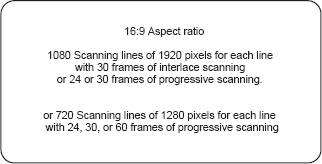HDTV… The ultimate television viewing experience.
High-Definition TV
As good as many of the new systems are, they still leave something to be desired. You may have seen very large-screen TVs and noticed that their pictures weren't as sharp and clear as those for smaller TV sets. That's because you have the same 525 lines spread out over a much larger area. Any time you spread a given amount of information over a larger area, it's not going to look as sharp and clear, even in digital formats. This demonstrates how much quality is lacking in a TV picture, compared to film. For many years there has been a great deal of research and development of TV systems that would produce a picture that approaches film quality. This is called high-definition television (HDTV). The early work on HDTV used analog video, but today everything is digital.
Production HDTV Standards versus Broadcast HDTV Standards
There are two aspects of HDTV: production and broadcast. Production is the technology and equipment used to record and create programming. Broadcasting is the method of sending that programming through the air, over cable, or via satellite to your home. Under the old NTSC system, the standard for both processes was the same. With the advent of digital technology, the processes can be very different. When the HDTV production standard was developed, a great deal of effort went into designing a system that would make it easy to convert video between the major broadcast standards in the world (NTSC, PAL, PAL-M). What was wanted was a universal system that would allow easy two-way conversion — a format that would be easy to convert from one of the broadcast standards or film to HDTV and easy to convert from HDTV to one of the broadcast standards or film.
The system developed is a component system that uses either 8-bit, 10-bit, or 12-bit processing; either 720 or 1080 scanning lines of 1920 pixels each; has a 16:9 aspect ratio; uses a 4:2:2 encoding ratio; can be scanned at 60 fields/30 frames interlace, 50 fields/25 frames interlace, 30 frames progressive, or 24 frames progressive per second; and requires a total of 60 MHz (30 MHz for the Y channel and 15 MHz each for the R-Y and B-Y channels).
One of the biggest changes for production people will be the 16:9 screen format. The wide-screen format is close to what movies have been using for years and is much wider than the traditional television screen. For sports this wider screen will make it easier to cover more of the field and action. For dramas, comedies, and news, directors and camera people will have more screen to use and will have to use it effectively without looking contrived.
Formats for high-definition digital television.

